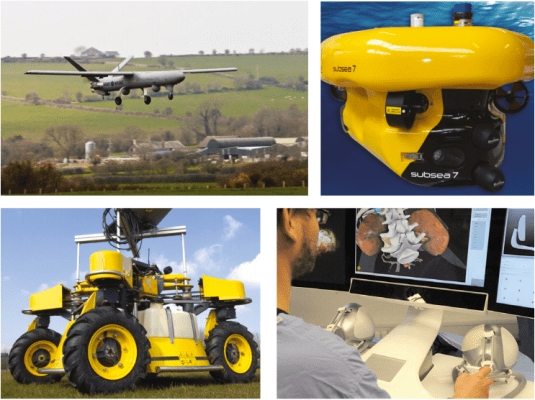The UK’s first official robotics strategy, drawn up with help from the Technology Strategy Board (TSB), is calling for the establishment of real-world test sites over the next five+ years where robotics and autonomous systems (RAS) can be rigorously put through their paces to help speed up development of our future overlords.
The wider hope is the national strategy will accelerate robotics development in the UK which has undoubtedly lagged behind other nations when it comes to pushing the autonomous envelope.
In 2012 the UK government identified RAS as one of eight technologies it views as crucial to the future rebalancing of the economy by fostering growth and creating jobs. Today’s strategy document follows on from that move, and is the product of work by a RAS Special Interest Group set up by the TSB in 2013.
The document calls for “defined and controlled spaces” test sites to be established where robotics can be trialled in the wild, as a stepping stone on the road to RAS technologies being deployed in the real world, alongside humans and other less smart machines.
“In many markets RAS technology will face regulatory hurdles. In others, gaining social acceptance may be the key to early adoption. Such barriers are best overcome by engaging with the customer and exposing innovation to the rigours of the real world, but this can only take place in real environments; laboratories are not enough,” the strategy notes.
“The UK can kick-start RAS by taking the lead and proactively opening up its regulations to allow RAS devices to operate in defined and controlled spaces. Such a proactive step would attract inward investment, gain valuable insights and attract the best in the world to the UK.”
UK sites being considered where robots could be allowed to roam around while still in development include decommissioned nuclear sites, farms, lakes and private roads.
In tandem to establishing real-world test sites, the strategy calls for a series of RAS Grand Challenge competitions focused on “real scenarios in vertical markets” to help “stimulate collaboration, identify the possibilities, and excite the public”. So, presumably, taking a leaf from the U.S. Darpa Grand Challenge playbook.
The British robotics competitions would be hosted at the real-world RAS test sites — which the document also describes as “collaborative proving grounds” — and would aim to underpin the nascent market and help robotics startups to scale faster.
“The intention is to expose RAS technology to the rigours of real environments; to identify technical strengths and weaknesses, and to explore commercial opportunities. Where appropriate these assets and associated challenges will span sectors, encouraging increased awareness of different approaches and solutions to generic problems. This will also have the effect of increasing early stage market size, which is critical to allow SMEs to scale,” the document notes.
There’s also presumably an element of getting the Great British public used to — and less worried about — seeing bots bouncing down their country lanes, or wandering lonely as a cloud o’er their fields and lakes.
“Our vision is to reinforce a RAS ecosystem in the UK that will develop skills and allow ideas and innovation to be created and tested in the market place, ahead of international competitors,” the document adds.
“Technological innovations must be demonstrated in real world environments because RAS tools will be expected to work reliably and efficiently in these places. Addressing this will also involve shaping key regulatory and standards issues, so that success attracts private and inward investment at a tipping point when public investment is no longer needed.”
Specific RAS areas identified as having future potential in the strategy document include unmanned aircraft systems and services, such as collision detection and avoidance systems; undersea robotics, for carrying out sub-sea inspection, repair and maintenance tasks, and for performing search and recovery functions; tools and processes for nuclear remote operations in decommissioning scenarios; intelligent mobility — aka driverless cars and other smart transport systems; and also farming where RAS can be developed to reduce the use of fertilisers and pesticides, improve land use, crop yields and lessen environmental impact.
